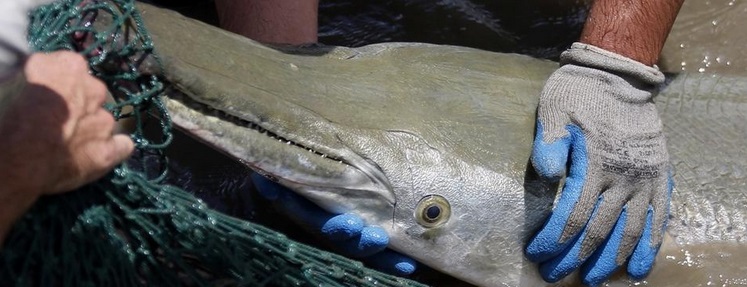Illinois officials have launched a management plan for the reintroduction of a species of primitive fish, but they’re also cautioning that it could take years before the effort makes any headway. The Department of Natural Resources Division of Fisheries also took the opportunity last week to reiterate that alligator gar, determined to be extirpated, or extinct, from state freshwater bodies of water since the early 1990s, weren’t being reintroduced to combat an invading Asian carp population, despite national stories to the contrary.

The hope, said DNR chief Dan Stephenson, is to create “a sustainable alligator gar population in southern Illinois,” with a side benefit to anglers and bow hunters.
The alligator gar, with its long, alligator-like head and two distinctive rows of needle-like teeth, is the largest of four gar species and has been known to grow as long as 8 feet and weigh 300 pounds. Prior to the reintroduction effort, which started in earnest about seven years ago, the last recorded catch of the fish in the state was by line-and-tackle in the Cache River basin in southern Alexander County in 1966.
Last fall, DNR Fisheries personnel stocked several lakes, including Sanganois State Fish and Wildlife Area, which is in parts of Cass, Schuyler and Mason counties, 40 miles northwest of Springfield, with about 1,600 12- to 16-inch fingerlings, said Stephenson. With recent flooding, however, he acknowledged that “half or all” of the alligator gar could be gone from Sanganois, dispersed to rivers as far away as Texas and Louisiana, where they are more numerous.
PIT (passive integral transponder) tags, which provides a permanent “barcode” for tracking the fish, were installed when they were stocked.
“We’re hoping we can track them, but with the flooding, we just don’t know,” said Stephenson, who is hoping that the division can use a more advanced tracking satellite in the future. “They’re already rare here.”
The reintroduction possibility gained traction when the American Fisheries Society unveiled a plan in 2010. The fact that the alligator gar was native to Illinois, going as far north as Beardstown in the Illinois River last century, and that it would have appeal to trophy hunters were among the reason the division climbed on board, said Stephenson.
There is a negligible cost associated with the reintroduction, he noted, because the state gets “fries” from the U.S. Fish and Wildlife Service, and two Mississippi-based hatcheries pay for the food to grow them before they are stocked in Illinois.
“We know it’s a long-term project,” said Stephenson, pointing to the fact that female alligator gar aren’t sexually mature until they’re about 11 years old. Alligator gars, which have enamel-like ganoid scales, can typically live 50 to 60 years.
Story written
